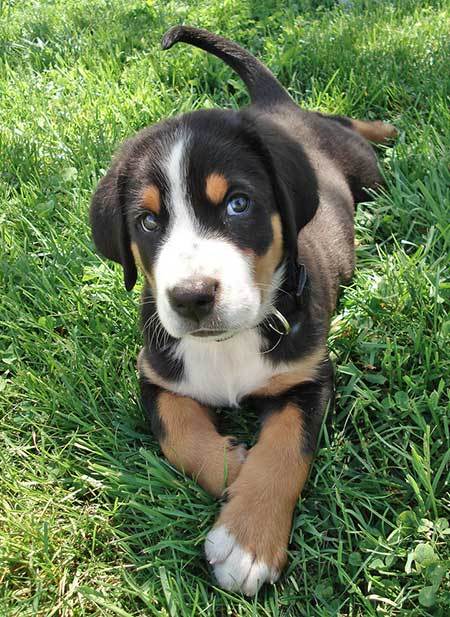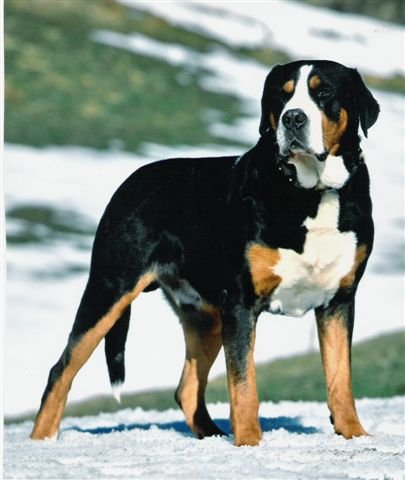| |
|
|
Greater Swiss Mountain Dog Information

Greater Swiss Mountain Dog Facts
| Size |
Large |
| Male Max Weight |
75-95 lb |
| Female Max Weight |
75-95 lb |
| Life Span |
10-12 years |
| Energy Level |
 |
| Ease of Training |
 |
| Grooming |
 |
| Shedding |

|
| Exercise Requirements |

|
| Playfulness |

|
| Affection Level |

|
| Good With Dogs |

|
| Good With Pets |

|
| Good With Strangers |

|
| Watchdog Ability |

|
| Protection Ability |

|
| Cold Tolerance |

|
| Heat Tolerance |

|
Greater Swiss Mountain Dog Temperament
|
The Greater Swiss Mountain Dog is known for it’s sensitive,
faithful, and extremely loyal family companionship. This breed of dog is relaxed,
laid-back, and exceptionally gentle with children, along with other pets. The
Greater Swiss Mountain Dog is also known for being very watchful, forward, and cautious
of its
surroundings.
|
Greater Swiss Mountain Dog Upkeep
|
The Greater Swiss Mountain Dog comes from a history of working
roots. With this background, this breed has gained a love for the outdoors,
especially in cold weather. It is important that this breed of dog gets adequate
daily exercise in the form of a good walk or an energetic romp. The Great Swiss
Mountain Dog can live outside in mild climate conditions, however would much prefer to be
inside with its family. This particular breed of dog needs plenty of space to
stretch out and relax. The Great Swiss Mountain Dog needs its coat brushed about
once a week, though more often when it is in its shedding
phases.
|
Greater Swiss Mountain Dog Health
|
This breed of dog has a life span of ten to twelve years.
There are many health concerns associated with the Greater Swiss Mountain Dog. The
biggest health concern for this breed is CHD. Some of the more minor health
concerns that this breed of dog possesses are panosteitis, distichiasis, gastric torsion,
seizures, and female urinary incontinence. It is suggested that the Greater Swiss
Mountain Dog has regularly scheduled elbow, eye, and shoulder tests to track consistent
health.
|
Greater Swiss Mountain Dog History
|
The Greater Swiss Mountain Dog holds the reputation as the
oldest and largest of four varieties of Swiss Mountain Dogs, also known as the
Sennenhunde. The other three varieties include the Appenzeller, the Entlebucher,
and the Bernese. Each breed shares a common heritage, most likely originating from
the Mastiff or Molossian dogs of the Romans. It is said that these breeds of dogs
were possibly introduced when the Romans crossed through Switzerland. However, a
different theory believes that the Phoenicians brought this breed to Spain around 1100
B.C. Either way, the Greater Swiss Mountain Dog spread over Europe and interbred
with native dogs, which eventually caused development along independent lines in remote
communities. These four varieties of Swiss Mountain Dogs generally shared the same
working ethic, dividing their responsibilities between acting as a guardian of livestock
and home, herder, and draft dog. All four varieties of dogs were generally assumed
to be the same breed or type up until the late 1800s. However, the truth was
discovered when Professor A. Heim attempted to study the Native Swiss Mountain breeds
seriously. In his research, he discovered consistent differences that allowed the
breeds to be categorized into four different and individual breeds. In 1908, the
Greater Swiss became a known breed when Professor A. Heim identified an amazing
short-haired dog entered into a Bernese Mountain Dog contest. He believed this to
be a separate breed from the rest and dubbed it the Greater Swiss. After this
discovery, the breed slowly grew in popularity. It was not until 1968 that the
Greater Swiss came to America. In 1985, the Greater Swiss Mountain Dog was finally
admitted into the AKC Miscellaneous category and achieved full recognition in
1995.
|
Greater Swiss Mountain Dog Pictures
|
Puppies

Middle
Aged

|
Greater Swiss Mountain Dog Videos
|
|
|





